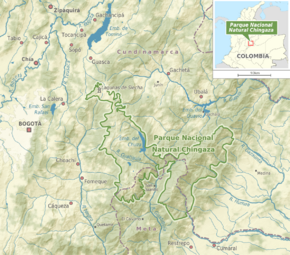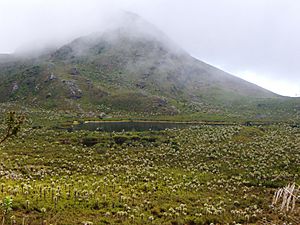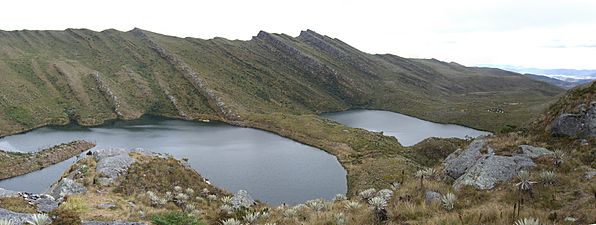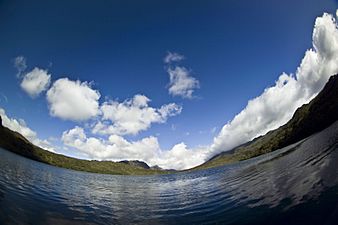Chingaza National Natural Park facts for kids
Quick facts for kids Chingaza National Natural Park |
|
|---|---|
|
IUCN Category II (National Park)
|
|
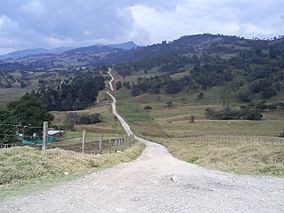
Road in Chingaza National Park
|
|
| Lua error in Module:Location_map at line 420: attempt to index field 'wikibase' (a nil value). | |
| Location | Colombia |
| Area | 76,600 hectares (189,000 acres) |
| Established | 1977 |
| Governing body | SINAP |
| Official name: Sistema Lacustre de Chingaza | |
| Designated: | 25 June 2008 |
| Reference #: | 1782 |
Chingaza National Natural Park (Spanish: Parque Nacional Natural (PNN) Chingaza) is a very special place in Colombia. It is located in the Eastern Andes mountains, northeast of Bogotá, the capital city. This amazing park stretches across parts of the Cundinamarca and Meta regions.
The land here goes from about 800 meters (2,625 feet) high to 4,020 meters (13,190 feet) high! The temperature can range from a cool 4°C (39°F) to a warmer 21.5°C (71°F). Chingaza is super important because it provides most of Bogotá's drinking water.
Contents
What's in a Name?
The name Chingaza comes from an old language called Chibcha. In this language, Chingaza means "middle of the width."
Waterways and Lakes
Most of Chingaza Park (99%) is part of the Orinoco River basin. This means that most of the rivers and streams in the park eventually flow into the Orinoco River. Only a small part (1%) drains into the Magdalena River basin.
Chingaza is home to about 40 natural lakes. These lakes were formed by glaciers a long time ago. The biggest lake is Lake Chingaza. It is located in the southwestern part of the park.
One of the most famous and important groups of lakes are the Siecha Lakes. These are three beautiful lakes found in the Guasca area. The Chuza Reservoir is also inside Chingaza Park. This reservoir is a key part of the system that provides 80% of Bogotá's clean drinking water.
Amazing Animals and Plants
Chingaza is full of incredible wildlife! You might spot animals like the spectacled bear, deer, tapirs, and even pumas. Birds like the Andean condor and Cock-of-the-rock also live here. Other animals include jaguars, turkeys, woolly monkeys, and toucans. The park has many unique species that are found nowhere else. This makes the Eastern Andes a very important place for wildlife in Colombia.
The park also has a huge variety of plants. Near Chingaza lake, over 383 different plant species have been found. Experts believe the park might have more than 2,000 plant species in total! There are special plants called peat moss that can soak up a lot of water, up to 40 times their own weight. You can also find frailejones, which are unique plants that grow in the high mountain grasslands called páramo.
People of the Area
Ancient Communities
Today, there are no indigenous groups living inside Chingaza Park. However, this area has a very long history. People from the Muisca and pre-Muisca cultures lived here for over 10,000 years. Lakes, rock shelters, and mountains were sacred places for them. The Siecha Lakes were especially important for ceremonies and worship. Some studies suggest that in the Chibcha language, Chingaza might have been called Chim-wa-za, meaning "God's Night Mountains."
Local Farmers
Around the park, there are rural communities of smallholder farmers. These communities have their own ways of life and traditions. They have strong connections to the land and to each other.
Named After Chingaza
Some new species discovered in the park have been named after Chingaza! This shows how special and unique the park is.
- Araneus chingaza, a type of spider
- Ischnura chingaza, a type of dragonfly
- Polylobus chingaza, a type of beetle
- Epidendrum chingazaënse, a type of orchid
Gallery
See also
 In Spanish: Parque nacional natural Chingaza para niños
In Spanish: Parque nacional natural Chingaza para niños
- Siecha Lakes
- Sumapaz Páramo


